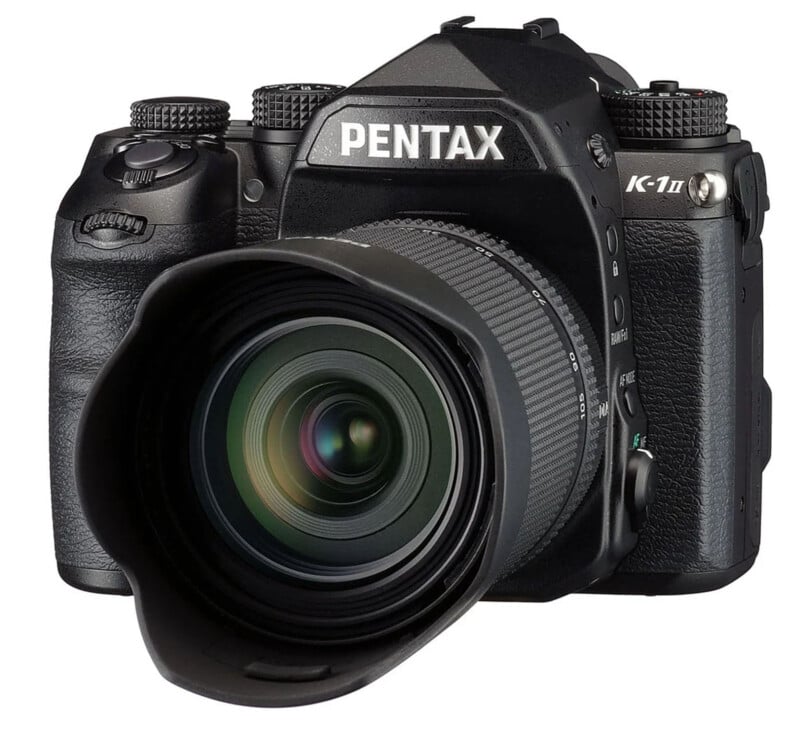
At a marketing event in Taipei earlier this month, Ricoh executives answered wide-ranging questions about Pentax’s strategy, including the status of the company’s DSLR cameras and its highly anticipated film camera revival.
As seen on Pentax Rumors, the Q&A session included Ricoh’s General Manager, Tomoki Tanaka, and Takeo Suzuki from the Pentax Division’s product planning development group. Suzuki was interviewed by David Etchells for PetaPixel earlier this year and is instrumental in the company’s camera design work.
Tanaka and Suzuki took questions from Pentax fans and supporters, and a guest kicked off the session with a request for more information on a potential Pentax K-1 Mark III. A new version of Pentax’s compact full-frame DSLR is overdue, with the current K-1 II launching in early 2018. To that, Ricoh says, per a machine translation, that the K-3 III’s development is actively underway but has been slowed by difficulties sourcing necessary components.
As for Pentax’s film camera project, several questions were met with minimal answers. Ricoh says that the film camera work is going well, but there is not much else to share now. However, Ricoh did mention that it hopes to gain partners through the film project and stimulate positive changes in the analog photography space.
Ricoh has long been ardent in its commitment to DSLR technology, and it seems this won’t change anytime soon. Asked about the possibility of developing mirrorless camera systems, Ricoh says that the difficulty of doing so is extremely high.

There also seems to be little hope for further developments in the medium-format 645 system, which remains an impressive, albeit very old, digital medium-format system. The 51.4-megapixel sensor in 2014’s 645Z paved the way for mirrorless systems like the Fujifilm GFX 50S and Hasselblad X1D 50C, but Pentax has not updated the 645 system since the 645Z hit store shelves. The Pentax 645 system is nearing its final days, although Pentax has not publicly committed to a specific end-of-life plan, only saying that the 645 is in its late stages.
The discontinued mirrorless Q Series is another Pentax series that has been gathering dust for a long time. Coincidentally, 2014 was also the last time a Q camera hit the scene. However, the Q-S1 was just a Q7 with a new coat of paint, rather than an outright new camera. Amid calls for a new Q camera, Ricoh says the company will conduct a feasibility study. Still, the Q series has “certain limitations in specifications” that make it challenging to restart the series.
![]() The Pentax Q-S1, the company’s last Q Series camera, was beautiful, albeit limited. Could the series get a revival down the road? [/caption
The Pentax Q-S1, the company’s last Q Series camera, was beautiful, albeit limited. Could the series get a revival down the road? [/caption
While it is easy nowadays to say, “Oh, Pentax, they only make DSLR cameras,” it is worth noting that the mirrorless Q cameras were exciting in their heyday. The original Pentax Q launched in 2011 was the world’s smallest and lightest interchangeable lens camera for a spell, and it even included a back-illuminated CMOS image sensor, an uncommon inclusion at the time.
Granted, the Q series cameras sported tiny image sensors. The original Q and Q10 cameras had type 1/2.3-inch sensors with a massive 5.5 times crop factor. The later Q7 and Q-S1 sported larger Type 1/1.7 sensors, which are still small and have a 4.65x crop. Compare that to a Micro Four Thirds camera and its two times crop factor. While the Q Series cameras may not have delivered class-leading image quality, they were undoubtedly beautiful, stylish, compact cameras.
If Ricoh continues to make meaningful progress on its new film camera and the K-1 Mark III, 2024 could be an excellent year for Pentax fans. PetaPixel is not so sure the film camera will arrive next year, but a vintage-inspired DSLR could be in the offing.
Image credits: Ricoh Pentax
